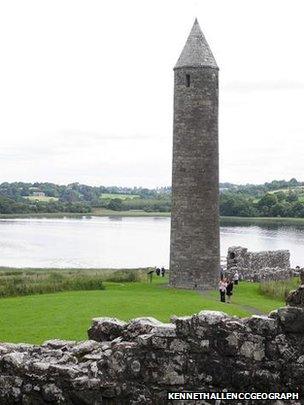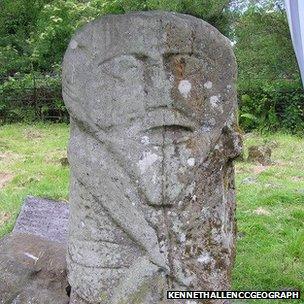Fermanagh: Northern Ireland's lakeland county
- Published

The round tower on Devenish Island
County Fermanagh is one of the six counties of Northern Ireland and lies on the border with the Republic of Ireland.
The landscape is an intricate patchwork quilt of woodland, forest, parkland and wetland, with 30% covered with lakes and waterways.
Normally considered the wettest county, Knockarevan in Fermanagh recorded the highest temperature in Northern Ireland of 30.8 °C in 1976.
The name of the county translates from Irish as men of the monks, with numerous monastic settlements on the islands of Lough Erne in the middle ages.
Devenish Island contains one of the finest examples, with a spectacular round tower.
However, its isolated location did not spare it from being raided by Vikings.
The Annals of Ulster were written in Fermanagh and are regarded as the most important source for the early history of Ireland, covering the arrival of St Patrick in the 5th Century to 16th Century.
The Maguires were the dominant clan in the area and Hugh Maguire was the first of the Irish chieftains to rise against the rule of Queen Elizabeth I.
After their defeat the lands of the chieftains were seized and many areas were colonised with people who the Crown thought would remain loyal, a process known as the Plantation of Ulster.
In 2001 the religious breakdown of the county was 57% Catholic and 41% Protestant with a population of just over 57,000 people.
The Royal Inniskilling Fusiliers was a regiment raised in the county, and surrounding areas, which formed part of the British Army from the 19th Century until it was amalgamated with the Royal Irish Rangers in 1968.
During the Second World War, Lough Erne was used as a base for Catalina flying boats to help protect Atlantic convoys. A secret deal with the Irish Republic allowed the planes to fly through Irish airspace.
Part of the Fermangh and South Tyrone constituency, it traditionally has the highest electoral turnout in Northern Ireland and while now a Sinn Fein held seat, it had an Ulster Unionist MP for nearly 18 years.

A two-headed stone on Boa Island
It also returned the IRA hunger Striker Bobby sands as an MP in 1981, one of the most important by-elections in Northern Ireland's history. He died in the hospital of the Maze prison twenty six days after being elected.
The largest town in the county is Enniskillen. Eleven people were killed and more than 60 injured when an IRA bomb exploded in a hall close to the town's war memorial on 8 November 1987. A 12th person died after 13 years in a coma.
The wit and playwright Oscar Wilde spent seven years at Portora Royal School in the county. Locals have claimed Wilde drew his inspiration for his fairy tale The Happy Prince from Cole's monument which stands nearby.
He won the school prize for the top classics student in each of his last two years, as well as second prize in drawing during his final year.
Other notable people with a link to the county include Samuel Beckett, also educated at Portora as was the singer Neil Hannon from The Divine Comedy and the actor Adrian Dunbar.
The county has occasionally loomed into the mind of statesmen.
Speaking after the end of the First World War, and with the partition of Ireland looming, Winston Churchill summed up the situation with these words: "The whole map of Europe has been changed ... but as the deluge subsides and the waters fall short we see the dreary steeples of Fermanagh and Tyrone emerging once again."